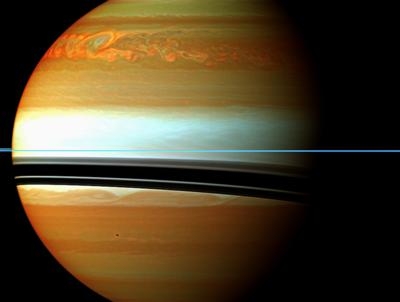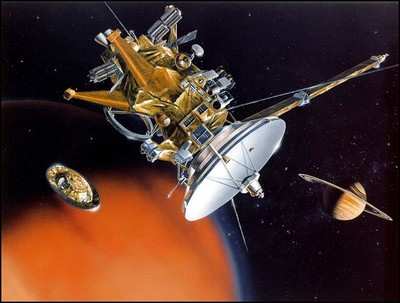Data Suggests Storm Was More Powerful Than Originally Estimated
NASA's Cassini spacecraft has tracked the aftermath of a rare massive storm on Saturn. Data reveal record-setting disturbances in the planet's upper atmosphere long after the visible signs of the storm abated, in addition to an indication the storm was more forceful than scientists previously thought.

Data from Cassini's composite infrared spectrometer (CIRS) instrument revealed the storm's powerful discharge sent the temperature in Saturn's stratosphere soaring 150 degrees Fahrenheit (83 kelvins) above normal. At the same time, researchers at NASA's Goddard Spaceflight Center in Greenbelt, Md., detected a huge increase in the amount of ethylene gas, the origin of which is a mystery. Ethylene, an odorless, colorless gas, isn't typically observed on Saturn. On Earth, it is created by natural and man-made sources.
Goddard scientists describe the unprecedented belch of energy in a paper to be published in the Nov. 20 issue of the Astrophysical Journal. "This temperature spike is so extreme it's almost unbelievable, especially in this part of Saturn's atmosphere, which typically is very stable," said Brigette Hesman, the study's lead author and a University of Maryland scientist who works at Goddard. "To get a temperature change of the same scale on Earth, you'd be going from the depths of winter in Fairbanks, Alaska, to the height of summer in the Mojave Desert."
First detected by Cassini in Saturn's northern hemisphere on Dec. 5, 2010, the storm grew so large that an equivalent storm on Earth would blanket most of North America from north to south and wrap around our planet many times. This type of giant disturbance on Saturn typically occurs every 30 Earth years, or once every Saturn year.
Not only was this the first storm of its kind to be studied by a spacecraft in orbit around the planet, but it was the first to be observed at thermal infrared wavelengths. Infrared data from CIRS allowed scientists to take the temperature of Saturn's atmosphere and to track phenomena that are invisible to the naked eye.

Temperature measurements by CIRS, first published in May 2011, revealed two unusual beacons of warmer-than-normal air shining brightly in the stratosphere. These indicated a massive release of energy into the atmosphere. After the visible signs of the storm started to fade, CIRS data revealed the two beacons had merged. The temperature of this combined air mass shot up to more than minus 64 degrees Fahrenheit (above 220 kelvins). According to Hesman, the huge spike of ethylene generated at the same time peaked with 100 times more ethylene than scientists thought possible for Saturn. Goddard scientists confirmed the release of the gas using the Celeste spectrometer mounted on the McMath-Pierce Solar Telescope on Kitt Peak in AZ. The team still is exploring the origin of the ethylene, but has ruled out a large reservoir deep in the atmosphere. "We've really never been able to see ethylene on Saturn before, so this was a complete surprise," said Goddard's Michael Flasar, the CIRS team lead.
A complementary paper led by Cassini team associate Leigh Fletcher of Oxford University, England, describes how the two stratospheric beacons merged to become the largest and hottest stratospheric vortex ever detected in our solar system. Initially, it was larger than Jupiter's Great Red Spot. Their paper in the journal Icarus, which combines CIRS data with additional infrared images from other Earth-based telescopes, including NASA's Infrared Telescope Facility at Mauna Kea, Hawaii, also reports a powerful collar of clockwise winds -- encompassing a bizarre soup of gases -- around the vortex. "These studies will give us new insight into some of the photochemical processes at work in the stratospheres of Saturn, other giants in our solar system, and beyond," said Scott Edgington, Cassini deputy project scientist at NASA's Jet Propulsion Laboratory (JPL) in Pasadena, CA.
The Cassini-Huygens mission is a cooperative project of NASA, the European Space Agency, and the Italian Space Agency. The mission is managed by JPL for NASA's Science Mission Directorate in Washington. Hesman's work was funded in part by NASA's Planetary Astronomy Program in Washington. The CIRS instrument and Celeste spectrometer were built at Goddard.
(Top image: The red, orange and green clouds (false color) in Saturn's northern hemisphere indicate the tail end of the massive 2010-2011 storm. Even after visible signs of the storm started to fade, infrared measurements continued to reveal powerful effects at work in Saturn's stratosphere. Credit: NASA/JPL-Caltech/Space Science Institute Bottom image Cassini spacecraft from NASA animation)
 NTSB Final Report: Rutan Long-EZ
NTSB Final Report: Rutan Long-EZ ANN FAQ: Turn On Post Notifications
ANN FAQ: Turn On Post Notifications Classic Aero-TV: ICAS Perspectives - Advice for New Air Show Performers
Classic Aero-TV: ICAS Perspectives - Advice for New Air Show Performers ANN's Daily Aero-Linx (06.28.25)
ANN's Daily Aero-Linx (06.28.25) Aero-News: Quote of the Day (06.28.25)
Aero-News: Quote of the Day (06.28.25)




